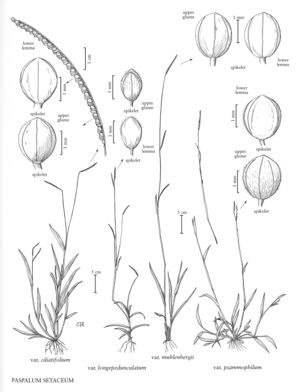Difference between revisions of "Paspalum setaceum var. ciliatifolium"
imported>Volume Importer |
imported>Volume Importer |
||
| Line 45: | Line 45: | ||
|publication year= | |publication year= | ||
|special status= | |special status= | ||
| − | |source xml=https:// | + | |source xml=https://bitbucket.org/aafc-mbb/fna-data-curation/src/2e0870ddd59836b60bcf96646a41e87ea5a5943a/coarse_grained_fna_xml/V25/V25_1475.xml |
|subfamily=Poaceae subfam. Panicoideae | |subfamily=Poaceae subfam. Panicoideae | ||
|tribe=Poaceae tribe Paniceae | |tribe=Poaceae tribe Paniceae | ||
Revision as of 21:03, 5 November 2020
Plants erect to spreading. Leaves mostly cauline; blades 2-32 cm long, 3-18 mm wide, lax to somewhat stiff, glabrous or with a few hairs along the midrib (rarely shortly pilose), dark green to purple, margins scabrous, ciliate. Panicle branches 2-11.9 cm; branch axes 0.6-1.2 mm wide. Spikelets 1.7-2 mm long, 1.2-1.5 mm wide, elliptic to obovate, pubescent or occasionally glabrous; lower lemmas with an evident midvein; upper florets 1.7-2 mm.
Discussion
Paspalum setaceum var. ciliatifolium is the most variable and widespread of the nine varieties of P. setaceum. It usually grows in sandy soil in open areas, including disturbed areas, of prairies and forest margins. Its range extends from Louisiana and the eastern United States to Panama, the West Indies, and Bermuda.
Selected References
None.
